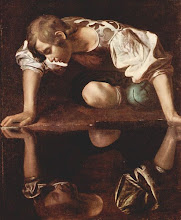
The above 1510 picture by Gossaert, otherwise known as Mabuse, is from Rotterdam's Museum Boijmans-van Bueningen, but does not appear to be on their website. The picture below by Spranger dates back to 1581 and is now in Vienna's Kunsthistorisches Museum. A few years later in 1585, Scarsella, otherwise known as Scarsellino also painted a picture of Salmacis and Hermaphroditus, now in Rome's Galleria Borghese, but not on their site.

This news report of Christie's activities in 2006 is illustrated by a photo of Lodovico Carracci's Salmacis and Hermaphroditus, which probably dates from the last decade of the 16th century (further details and another photo here).
The two pictures below date from the first decade of the 17th century. The upper one is by Badalocchio and is now in Rome's Galleria Pallavicini, while the lower one is by Carlo Saraceni and is now in Naples's Galleria di Capodimonte, but neither appears to be on its gallery's website.


At about the same time the poet and playwright Francis Beaumont (of Beaumont and Fletcher fame) was writing an epyllion or short epic poem on the subject of Salmacis and Hermaphroditus.
Wtenbrouck's 1627 picture, Wooded Pool With Salmacis and Hermaphroditus, is now in The Hague's Mauritshuis.
Albani painted two paintings on the theme of Salmacis and Hermaphroditus: one, dating from the 1630s is in Paris's Louvre, while the other (shown below), from about 1660, is in Oldenburg's Landesmuseum, but again not on their website.

Moving on to the 19th century, François-Joseph Navez painted the picture of the Nymph Salmacis and Hermaphroditus below in 1829, and it is now in Ghent's Museum voor Schone Kunsten.

Another poet, Swinburne, wrote a poem called Hermaphroditus, and dated it Au Musée du Louvre, Mars 1863. He was presumably inspired by this statue in the Louvre. The statue itself is from the 2nd century AD but the mattress for it was carved in 1619 by Bernini.

You can see images from an undated, but presumably quite recent, film about Salmacis and Hermaphroditus.
The modern Australian artist Josonia Palaitis has painted a series of works based on Ovid's Metamorphoses, one of which shows Salmacis and Hermaphroditus.





2 comments:
I'm writing to let you know that I have recently discovered your blog. I consider it an internet equivalent of the great wonder rooms of the pre-digital past and have recommended it to the readers of my blog.
Thanks for the kind words. I must confess I hadn't heard of William Hone before, but I'll have to put him down on my list of people to blog about.
Post a Comment